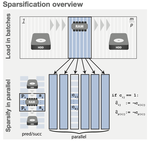
Abstract
Since the amount of published biological sequencing data is growing exponentially, efficient methods for storing and indexing this data are needed to truly benefit from this invaluable resource for biomedical research. Labeled de Bruijn graphs are a frequently-used approach for representing large sets of sequencing data. While significant progress has been made to succinctly represent the graph itself, efficient methods for storing labels on such graphs are still rapidly evolving. In this paper, we present RowDiff, a new technique for compacting graph labels by leveraging expected similarities in annotations of vertices adjacent in the graph. RowDiff can be constructed in linear time relative to the number of vertices and labels in the graph, and in space proportional to the graph size. In addition, construction can be efficiently parallelized and distributed, making the technique applicable to graphs with trillions of nodes. RowDiff can be viewed as an intermediary sparsification step of the original annotation matrix and can thus naturally be combined with existing generic schemes for compressed binary matrices. Experiments on 10,000 RNA-seq datasets show that RowDiff combined with Multi-BRWT results in a 30% reduction in annotation footprint over Mantis-MST, the previously known most compact annotation representation. Experiments on the sparser Fungi subset of the RefSeq collection show that applying RowDiff sparsification reduces the size of individual annotation columns stored as compressed bit vectors by an average factor of 42. When combining RowDiff with a Multi-BRWT representation, the resulting annotation is 26 times smaller than Mantis-MST.
